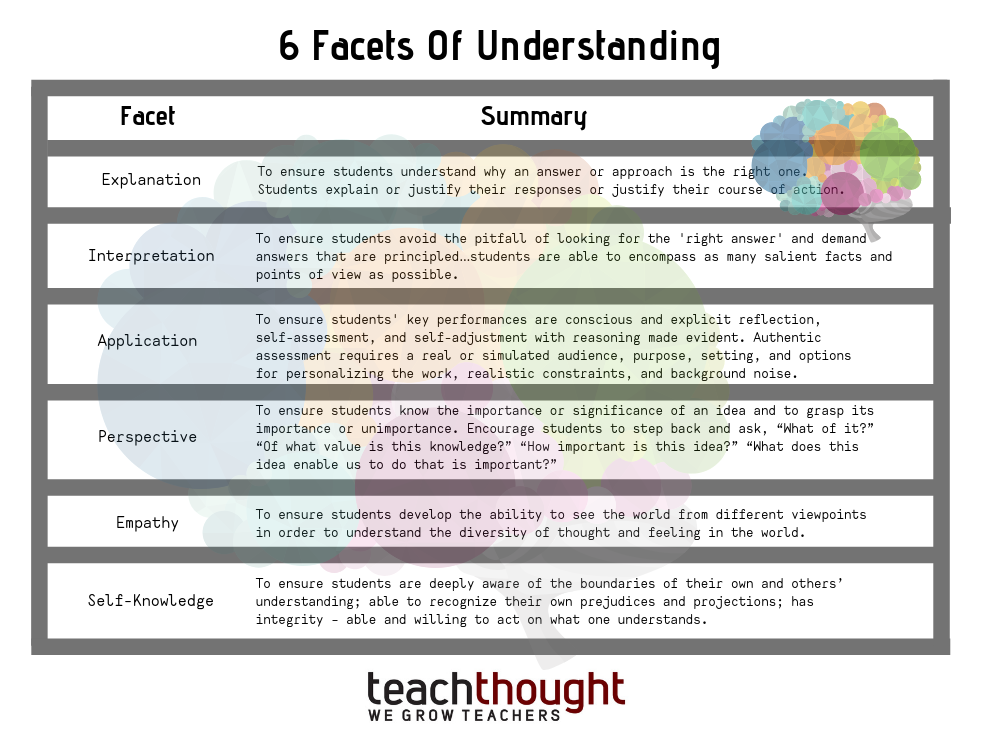
What Are The 6 Facets Of Understanding?
by Terry Heick
Definition: The 6 Facets of Understanding is a non-hierarchical framework for understanding. It is made up of 6 ‘domains’ or ‘facets’ that are useful as indicators of understanding
The framework was created by Grant Wiggins and Jay McTighe to work with and through their Understanding by Design model. Because it is intended to, in part, support teachers in evaluating and assessing student understanding, it can not only be used to design assessments but also create the activities and lessons designed to lead to that understanding. (Think backward design.)
See also 50 Examples Of Analogies For Critical Thinking
The six facets appear in the bulleted list below.
The 6 Facets of Understanding
All summaries and definitions (italicized) are taken from Understanding by Design, Expanded 2nd Edition.
Explanation
Explanation asks students to tell the ‘big idea’ in their own words, make connections, show their work, explain their reaosning, and induce a theory from data.
Interpretation
Interpretation requires the student to make sense of stories, art works, data, situations, or claims. Intepretation also involves translating ideas, feelings, or work done in one medium into another.
Application
Students who understand can use their knowledge and skill in new situations (and) place emphasis on application in authentic contexts with a real or simulated audience, purpose, settings, constraints, and background noise.
Perspective
Perspective is demonstrated when the student can see things from different points of view, articulate the other side of the case, see the big picture, recognize underlying assumptions, and take a critical stance.
Empathy
Intellectual imagination is essential to understanding and it manifests itself not only in the arts and literature but more generally through the ability to appreciate people who think and act differently than us.
Self-Knowledge
…through self-assessment we gain complete insight into how sophisticated and accurate students’ views are of the tasks, crieria, and standards they are to master.
Using The 6 Facets of Understanding In Your Classroom
Unlike Bloom’s Taxonomy (and Bloom’s Taxonomy power verbs), the 6 Facets of Understanding is a non-hierarchical framework–meaning that there are not ‘lower levels’ and ‘higher levels’ of thinking. ‘Self-Knowledge’ isn’t prioritized over ‘Explanation,’ for example. Nor is one facet ‘superior’ over another.
Rather, Grant and Jay intended for the ‘facets’ to be used to support teachers and students by providing strategies to help assess understanding. And since traditional content areas range so dramatically–from arts and literature to language and math–the idea is to create a framework flexible enough to work in variety of contexts and needs.
In a 2014 white paper published by ASCD, Grant and Jay offered some background on the 6 Facets of Understanding.
The Six Facets of Understanding were conceived as six equal and suggestive indicators of understanding, and thus are used to develop, select, or critique assessment tasks and prompts. They were never intended to be a hierarchy. Rather, one selects the appropriate facet(s) depending on the nature of the content and the desired understandings about it…We have never suggested that a teacher must use all of the facets when assessing students’ understanding. For example, an assessment in mathematics might ask students to apply their understanding of an algorithm to a real-world problem and explain their reasoning. In history, we might ask learners to explain a historical event from different perspectives. In sum, we recommend that teachers use only the facet or facets that will provide appropriate evidence of the targeted understanding.
Contributing Factors: the diverse assessment needs across different content areas, culture, technology access levels, etc; Grant and Jay’s excellent Ubd work over the years; a combination of standardized test pressure narrowing our view of ‘understanding’ and the expanding view of learning models above and beyond textbook work and pencil-and-paper assessment, the ‘Whole Child‘ approach to teaching and learning
Related Educational Concepts: Understanding by Design, Instructional Design, Bloom’s Taxonomy, Assessment, Critical Thinking, Project-Based Learning, Student-centered learning
Related Teaching & Learning Resources: Bloom’s Taxonomy questions, The 40/40/40 rule, UbD planning templates
You can read more about the 6 Facets of Understanding on ASCD, and of course in the many volumes of useful UbD materials printed over the years.
The 6 Facets Of Understanding: A Definition For Teachers
